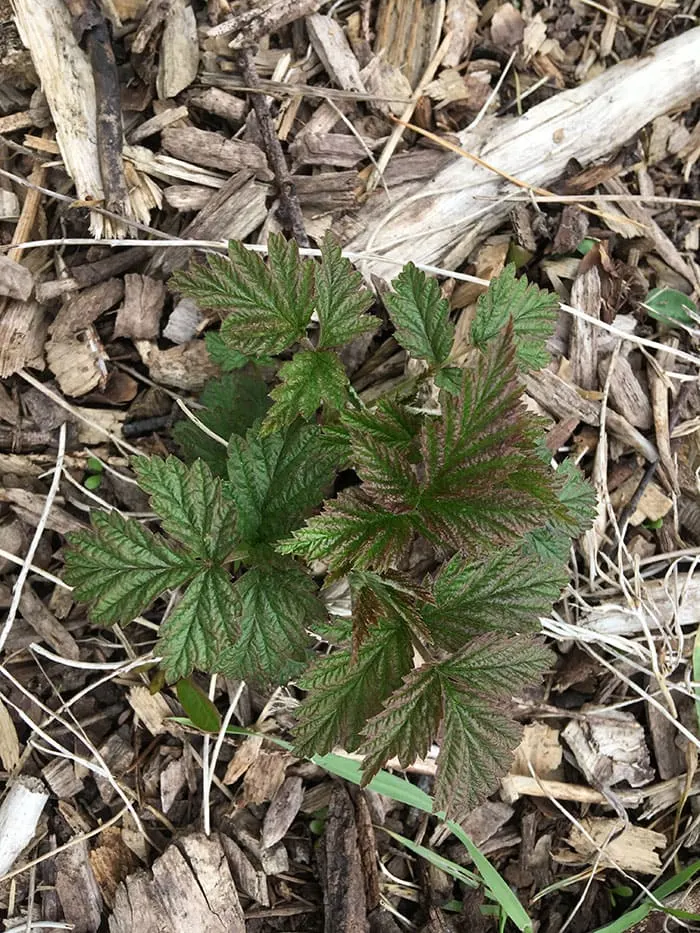This post may contain affiliate links, my full disclosure can be read here. As an Amazon Associate I earn from qualifying purchases.
Transplanting raspberries from plants or suckers is the perfect way to expand your raspberry patch to grow more fruit, share with a friend, or bring your raspberries with you when you move. With a few simple tips, you can learn how to transplant raspberries easily.
Raspberries are a great soft fruit bush to add to your backyard garden. They need little care and because they are perennial plants they will provide your family with fruit for years to come.
If you have been growing raspberries for a little while and want to increase how many plants you have there are multiple ways you can do this without buying new plants.
Or maybe you don’t have a raspberry patch yet but you have friends that do.
One of the easiest ways to get started is to dig up the young raspberry suckers also called runners that the plants produce.
This simple way of moving raspberries also works great if you need to move your raspberry bushes to a new area of your yard or if you are moving to a new home and want to take your berries with you.
We have a huge raspberry patch in our garden and they are the same raspberries I bought when I was a kid and planted in my garden. They have been planted and dug up 4 or 5 times over the years as we moved and to share with friends.

Propagating Raspberries From Runners
Raspberry plants spread naturally by growing roots horizontally through the ground. From these roots, they then start to send up new plants.
When the raspberry plants are young these suckers come up close to the plant, but as the plants get older and have a better root system they start to spread out.
This means once you have an established raspberry patch the easiest way to multiply your raspberry plants is to dig up these suckers and transplant them to another area of your garden.
How To Transplant Raspberries
1. Prepare A New Planting Area
Before digging up the young plants take time to prepare your new planting area or containers.
Select an area that gets full sun to part shade and has good soil. If you have heavy clay or sandy soil add 4 inches (10.6 cm) or more of compost to the soil before planting to help with nutrients and drainage.
Dig a hole or trench deep enough to replant them at the same depth they were already growing in.
If using containers fill a 4 inch (10.6 cm) or larger pot with good potting mix halfway. After adding the young plant later fill in around it with more soil mix.
2. Select Your Raspberry Suckers

Once the new home of your raspberries is ready it’s time to dig out the new primocanes (suckers).
Look for suckers that have started to grow outside of your original raspberry patch. You will want healthy-looking plants without any broken canes or damage.
These young plants will have a tap root that connects back to the parent plant. The easiest ones to transplant are 5-8 inches (12.7-20.32 cm) tall. By this stage, they have already started growing their own roots.
But don’t worry, if all of your raspberry plants are larger you can still transplant them.
3. Dig Up Raspberry Suckers
Using a spade cut straight into the soil between the sucker and the original plant. Make sure the cut is 4 inches (10.6 cm) away from the suckers canes so you don’t damage the new growth.
This will sever the young plant from the parent plant.
Continue to dig around the plant and under it keeping as much root attached as possible.
If you prefer, you can remove some of the soil from around the base of the plant, after breaking off the main root to the parent. Then holding the base of the young plant wiggle it back and forth in a circular motion until the sucker comes out of the soil.
This will give you a plant with little to no soil attached to its roots and makes it easier to transplant into containers.
4. Transplant
Then place the young raspberry plant into your prepared planting hole or container, adjusting it so it sits upright correctly. Space the plants 18 inches (45.72 cm) apart and make the rows 4 feet (1.2 m) apart so they have lots of room to grow.
Backfill the holes or trench with soil and water well.
Top with a layer of mulch to help keep the soil from drying out.
It’s normal for newly transplanted raspberries to wilt after transplanting. They are used to getting food through their parent tap root but if you keep them well watered they will perk back up in a few days to a week.
5. Prune
If the raspberry suckers you transplanted were very tall you can cut the canes back to 6 to 9 inches (15.24 to 22.86 cm).
This gives the plant less foliage to try to support after being transplanted and can help to encourage it to produce new canes.
How To Fix Raspberry Transplant Shock

It’s common for any plant including raspberries to go into shock after being dug up and transplanted. Within a few hours of transplanting you’ll see that the leaves have started to wilt and the stem may also droop over.
To help the plant recover make sure to water it consistently keeping the soil moist but not soggy. If you have planted raspberries in containers keep them in a shaded area. This will also help the pots to not dry out too fast.
When Is The Best Time To Transplant Raspberries?
The best time of year to transplant raspberries is in the early spring or late fall when the plants are dormant. But I have successfully transplanted raspberry plants in the late spring to mid-summer without any problems.
Watering consistently and cutting the plants back will help mid-season transplants recover quickly.
Connect With Homestead Acres!
Be sure to follow me on social media, so you never miss a post!
Facebook | Twitter | Pinterest | Twitter
Visit my Amazon store to find all my favorite gardening, homesteading tools, and gadgets plus all of my printed garden books and journals!

Kim Mills is a homeschooling mom of 6 and lives on an urban homestead in Ontario, Canada. Blogging at Homestead Acres she enjoys sharing tips to help you save money, grow and preserve your own food.

Michelle Gryba
Wednesday 3rd of May 2023
Thanks for the info! Hoping to share some plants with friends this year and pass on some of the deliciousness.